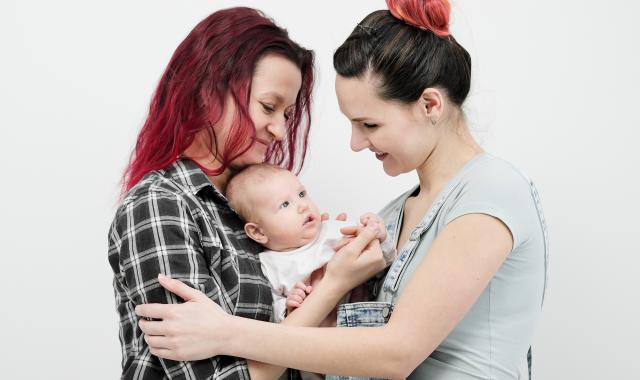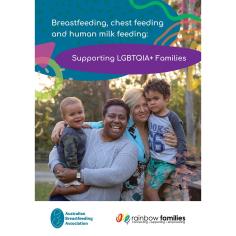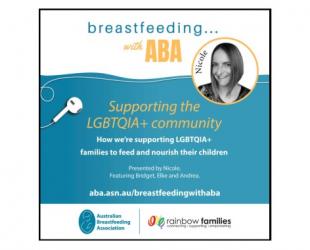In some families, both lactating parents feed their baby or child.

How co-feeding works can vary a lot between families and the roles can change over time.
People who co-feed may include those who are:
-
Already feeding at least one baby or child and have a well-established milk supply.
-
Making milk after birthing a baby.
-
Not currently feeding a baby or child and want to start (induce) breastfeeding or start breastfeeding again (relactate).
Some examples of co-feeding arrangements are:
-
The birthing parent feeds for the first 6 to 8 weeks and a second lactating parent shares the feeding after that time.
-
One lactating parent provides most of the feeds and a second lactating parent feeds overnight or one feed each day.
-
One lactating parent provides all feeds for the first few months and then a second lactating parent provides all the feeds after that time, for example when the first parent returns to work.
Co-feeding a young baby
When you give birth, the removal of the placenta triggers your milk production. Over the next 6 to 8 weeks, your supply gradually adapts to make only what their baby takes. Babies will control milk production if they can attach and remove milk well and can drink as much as they need as often and for as long as they want.
If you have not given birth, expressing by hand or with a pump can build a milk supply before your baby is born. However, many parents wait until after the baby is born to relactate or induce lactation because the easiest way to build a milk supply is often through a baby’s suckling.
In the early weeks your baby will likely be feeding from the birthing parent, receiving colostrum and helping them to establish their milk supply. Once their milk supply is well-established, after about 6 weeks, you can slowly change to either partial or complete feeding by another lactating parent.
Over time, as co-feeding parents, you may develop a feeding pattern which allows both of you to provide regular feeds. You each maintain a partial milk supply and together you will be able to meet your baby’s needs. You can check if your baby is getting enough milk by paying attention to the signs of supply.
Making milk when you haven’t given birth
It is possible for a person who has never been pregnant or given birth to make milk. This makes it possible for non-birthing parents to feed their baby from their body whether they have a baby born to a partner, a baby born via surrogacy, or an adopted child.
There are two terms that may apply when bringing in a milk supply:
-
Relactation occurs when someone wants to re-start a milk supply at any time after having been pregnant. You can relactate for a baby you have given birth to or for another baby.
-
Induced lactation is the process of building up a milk supply if you have never been pregnant.
In both situations, your breast tissue starts from a non-lactating state and needs to be stimulated to make milk. If you have been pregnant (or have fed a baby before) you may find it easier to make milk than if you haven’t, because pregnancy changes breast tissue. However, this is not always the case.
Situations where you may be thinking about relactating or inducing lactation:
-
You are in a same-sex relationship and are not the birthing parent.
-
You are a transgender or gender diverse parent, but not the birthing parent.
-
You are adopting a baby or toddler.
-
Your baby is being born via surrogacy.
What do I need to make it work?
People vary hugely in how easily they can build up a milk supply and this can make it seem very complex. However, there are really only four things needed:
-
A desire to make milk to feed your baby.
-
Knowledge about lactation.
-
A suckling baby or expressing by hand or with a pump.
-
Support people to build confidence.
Lactating as a transgender or gender diverse person
Many transgender and gender diverse parents nurture and nourish their children from their body, in very similar ways to other parents. Feeding from the body is not only about the amount of milk produced, but also about the feeding relationship. Not every transgender and gender diverse person has had surgery and not every transgender and gender diverse parent will use hormones. How lactation and feeding work for you will depend on your own situation and choices.
The emotional challenges of co-feeding
For some, co-feeding brings emotional challenges — the effort of keeping up more than one milk supply, sorting out roles and feelings of envy and jealousy. There can be mixed emotions if a lactating parent is weaning, as well as sadness and grief if the co-feeding didn’t work out as planned. These emotions are common and normal. If you are struggling with emotions around co-feeding, reach out for help.
Co-feeding can be a journey in many ways. Plan, negotiate, be flexible and get good information and support. Many families find they can develop a feeding pattern that works for them.
© Australian Breastfeeding Association August 2022
More resources for you
A resource to support LGBTQIA+ families.
Published by ABA and Rainbow Families NSW.
Breastfeeding, chest feeding and human milk feeding



